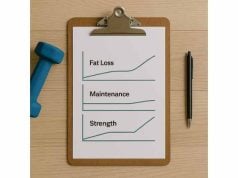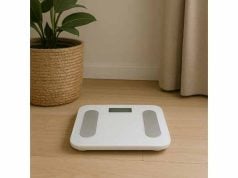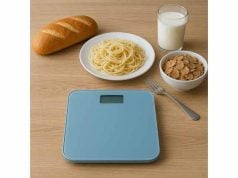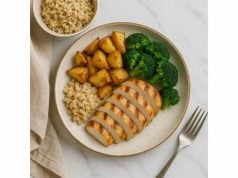
A glass of wine here, a beer after work, a cocktail on the weekend—individually, none of these feels like a big deal. Yet alcohol is a stealthy disruptor when you are trying to lose fat. It adds fast calories, blunts fat burning while your body clears ethanol, increases appetite, and degrades sleep and training. If the scale has not moved for two to four weeks, alcohol is one of the first variables to audit. This guide explains the “why,” then shows you exactly what to change—without forcing an all-or-nothing approach. If you need a broader framework for plateaus, bookmark our concise plateau troubleshooting guide.
Table of Contents
- Why alcohol stalls weight loss
- How much alcohol derails a deficit?
- What alcohol does to hunger, sleep and training
- What to change this month
- Smart swaps and drink choices
- How to track progress with alcohol in the mix
- When to pause alcohol entirely
- Frequently Asked Questions
Why alcohol stalls weight loss
Alcohol disrupts fat loss through four compounding effects: immediate calories, metabolic priority, appetite changes, and behavior drift.
1) Immediate calories. Ethanol contains ~7 calories per gram. One standard drink (about 14 g ethanol) provides ~98 calories before mixers. Five ounces of wine or a 12-ounce regular beer often land around 120–200 calories. Cocktails can run 200–400+ calories, especially with syrups, juice, or cream liqueurs.
2) Metabolic priority. Your body treats alcohol as a toxin to be cleared first. While the liver processes ethanol into acetate, fat oxidation is dialed down. You still store dietary fat eaten with those drinks, and you will not meaningfully tap body fat until alcohol is out of the system. This does not “erase” the whole day’s progress, but it pushes fat burning later and reduces the daily deficit.
3) Appetite and restraint. Alcohol lowers dietary restraint, increases food reward, and makes salty, high-fat foods more appealing. Even two drinks can lead to hundreds of “extra” calories from snacks or late-night food that would not have happened sober.
4) Behavior drift. Drinking frequently shifts bedtime, fragments sleep, and makes morning training easier to skip. The downstream effect is fewer planned workouts and lower daily movement (NEAT), which reduces total energy burn.
Add these up and alcohol becomes a common reason weight stalls. The math is simple: if your weekly calorie deficit is ~3,500–4,000 calories (about a pound of fat), three social nights with two drinks each can add ~600–900 liquid calories. If those nights also trigger extra food, you may erase the whole weekly deficit.
If you are rebuilding the foundations while you adjust alcohol, skim our succinct weight loss guide to ensure calorie awareness, protein intake, and activity are aligned.
Key takeaway: Alcohol does not break your metabolism; it crowds out your deficit and nudges choices that slow fat loss. Manage exposure, plan ahead, and you can still make steady progress.
How much alcohol derails a deficit?
You can fit alcohol into a fat-loss phase, but the margin for error is small. Think in weekly totals and event design, not vague “moderation.”
Set a weekly ceiling. A practical limit during active fat loss is 0–4 standard drinks per week, split across one or two occasions, not daily. This preserves most of your deficit and minimizes spillover into sleep and snacking. If you drink more than four, expect progress to slow or stall.
Design the occasion. Plan alcohol in a protein-anchored meal (30–40 g protein), and make the first drink late in the meal. Delay the first sip; you will finish fewer drinks with better satiety. Choose a hard stop (e.g., two drinks, last drink by 8:30 p.m.) before the event starts.
Use the 2×2 rule. No more than two drinks per occasion, no more than two occasions per week, and not on back-to-back days. This spacing avoids stacking poor sleep and encourages training between events.
Calorie budgeting method.
- Each standard drink ≈ 100 calories (rounding 98 to keep it simple).
- Cocktails vary—log them as 150–250 calories unless you know exact ingredients.
- If you plan two drinks on Saturday, budget 200–300 calories from earlier that day (e.g., smaller starch portion, leaner sauce) rather than starving all day—a tactic that backfires.
Watch the weekend effect. Many people are accurate Monday–Thursday and lose the deficit Friday–Sunday with drinks and social meals. If that is you, read our guide on weekend overeating and pair it with the limits above.
Example week that still loses fat:
- Mon–Thu: 1,700 calories/day, 140 g protein, training and 8–9k steps.
- Fri: No alcohol, normal dinner, early bed.
- Sat: Two drinks with a protein-heavy dinner, home by 10 p.m.
- Sun: Alcohol-free, long walk, prep food for Monday.
Key takeaway: Progress continues when drinks are infrequent, capped, and placed into meals you already control. The more often you drink, the more your weekly deficit shrinks.
What alcohol does to hunger, sleep and training
Alcohol’s effects do not stop when you put the glass down. They carry into hunger signals, sleep architecture, and next-day performance.
Hunger and cravings. Alcohol increases the appeal of high-fat, high-salt foods. It also reduces dietary restraint, making “just one slice” turn into several. The effect is strongest when you drink before eating or on an empty stomach; blood alcohol rises faster, and food choices degrade.
Sleep quality. Alcohol may speed sleep onset, but it fragments sleep, suppresses REM, and elevates resting heart rate. Even small amounts close to bedtime lower recovery markers. Poor sleep increases next-day hunger, lowers willpower, and reduces spontaneous movement—another hit to your calorie balance.
Training and NEAT. Alcohol impairs power output and coordination in the short term. The next day, you are more likely to skip or underperform a workout, and you move less overall (NEAT). That is a double cost: you lose the session’s burn and the adaptation signal that maintains muscle during a cut.
Water retention and the “fake stall.” Sodium-heavy bar foods plus alcohol can cause temporary water retention. The scale may spike for 24–72 hours. This is not new fat; it is fluid and glycogen shifts. Recognize the pattern so you do not overcorrect.
Countermeasures that work:
- Eat a protein-rich meal first; drink second.
- Hydrate: 500 ml water with electrolytes before the event; another 500 ml after the last drink.
- Curfew: last drink 3–4 hours before bed.
- Plan tomorrow: schedule training or a long walk the day after; set an alarm and put your shoes by the door.
For a deeper look at recovery, see our notes on sleep and fat loss and apply them on nights when you do not drink to keep your average sleep quality high.
Key takeaway: Alcohol’s hidden cost is the day after—poorer sleep, hungrier appetite, and less movement. Limit night-caps, protect sleep, and your next day will look like a fat-loss day again.
What to change this month
Treat the next four weeks as a controlled experiment. Keep your food pattern steady and change alcohol exposure first. Here is a month-long playbook that maintains your social life while restarting progress.
Week 1 — Audit and cap.
- Log every drink accurately; note when you drank relative to meals and bedtime.
- Cap at two occasions, two drinks each, no back-to-backs.
- Anchor both occasions to protein-heavy dinners; set a drink curfew.
Week 2 — Move and protect sleep.
- Add 1,500–2,500 steps the day after each occasion.
- Set lights-out 30 minutes earlier on alcohol-free nights to recover REM.
- Keep fluids up: 1.5–2 liters of water by midday; include electrolytes if you sweat.
Week 3 — Reduce frequency or volume.
- Shift one occasion to alcohol-free (mocktail, seltzer with lime).
- If you still drink, cut to one drink and choose a lower-calorie option.
- Reassess: Are the scale average and waist moving? If yes, hold steady.
Week 4 — Tighten the budget or adjust calories.
- If progress is still flat, remove alcohol entirely this week to test its effect.
- Alternatively, drop 100–150 food calories on drink days only (e.g., smaller starch portion), not every day.
- Keep protein at 0.7–1.0 g per pound of goal body weight.
If you need to tune your intake while you make these changes, use our primer on how to adjust calories and macros without crashing energy or training.
Decision rules that end stalls:
- No drinks within 3–4 hours of bedtime.
- No drinks the night before important training.
- No drinks on back-to-back days during a cut.
Key takeaway: Change frequency and timing before you cut more food. You will protect training, sleep better, and restore a sustainable weekly deficit.
Smart swaps and drink choices
You do not need elaborate “diet cocktails.” You need lower-calorie bases, simpler mixers, and sensible portions.
Lower-calorie options (rough estimates):
- Dry wine (5 oz): ~110–130 cal. Choose dry varieties; skip dessert wines.
- Light beer (12 oz): ~90–110 cal. Watch ABV; higher alcohol means more calories.
- Spirits (1.5 oz) + zero-cal mixer: ~95–110 cal. Soda water, diet tonic, or plain water.
- Hard seltzer (12 oz): ~90–110 cal, varies by brand.
Choices that creep up calories:
- Tiki drinks, margaritas, and creamy cocktails (often 200–400+ cal).
- Sweet mixers (tonic, juice, regular soda).
- Large formats (pints, 9-oz “heavy pour” wine, doubles).
Portion and pace tactics:
- Order single pours only.
- Alternate each drink with 500 ml water.
- Make the first drink the only drink on weeknights.
- If offered another round, switch to seltzer with lime—you keep a glass in hand and the social rhythm continues.
Food pairing strategy:
- Start meals with lean protein and vegetables; starch last if still hungry.
- Avoid “drinking on empty.” Have a small protein snack (Greek yogurt, jerky, cottage cheese) 60–90 minutes before social events.
For more satiety tactics to offset liquid calories, scan our guide to high-volume eating during plateaus.
Key takeaway: Favor dry, single-ingredient drinks with calorie-free mixers, keep pours standard, and pair alcohol with protein-anchored meals.
How to track progress with alcohol in the mix
Alcohol adds noise to your data through water retention and schedule changes. Tighten your tracking so you separate signal from noise.
Daily weigh-ins, weekly average. Weigh daily under the same conditions and look at the 7-day average. Expect a bump for 1–3 days after drinking; judge the trend, not the spikes.
Log drinks precisely. Track standard drinks rather than vague “glasses.” Use:
Calories from alcohol ≈ drinks × 14 g × 7 cal/g → about 98 calories per drink. For cocktails, log 150–250 unless you know the recipe.
Track two non-scale metrics.
- Waist at navel once per week upon waking.
- Photos in consistent light monthly, or clothes fit notes.
Pair data with behavior notes. Annotate your log on drink days: bedtimes, cravings, snack choices, steps, workout quality. Patterns jump out quickly.
If the scale is static but your waist and photos improve, you may be recomping. Use our guide to track without the scale and stay the course.
Decision thresholds:
- No change in 7-day weight average and waist for 3–4 weeks → reduce drinks or pause alcohol.
- Sleep score and step count consistently drop after drink nights → move alcohol earlier or pull it on training days.
Key takeaway: Measure what matters, smooth the data, and let trendlines—not single days—drive your decisions.
When to pause alcohol entirely
There are moments when the best move for your goals—and sometimes your health—is a full stop, at least for a season.
During aggressive fat loss. If you are in a large deficit or have a short deadline (e.g., making weight for sport, medical requirement), alcohol’s recovery cost is too high. Remove it for 4–8 weeks and reintroduce slowly later.
When sleep or stress is fragile. If you are waking at 3 a.m., dragging through days, or relying on alcohol to “unwind,” pause. Alcohol lowers sleep quality and resilience; the short-term relaxation is offset by fractured sleep and next-day anxiety.
If drinking displaces training. When nights out lead to missed lifts, poor run sessions, or lower steps, alcohol directly attacks the behaviors that preserve muscle and metabolic health during a cut.
Medical interactions and safety. If you take medications that interact with alcohol, are pregnant or trying to conceive, or have a history of problematic use, abstain and speak with your clinician.
Use a defined break. Commit to 30 days alcohol-free while keeping food, protein, and training steady. Watch how sleep, hunger, and weight respond. Many people see an immediate trend change and choose to keep alcohol occasional afterward.
Key takeaway: A clean break removes noise, restores sleep, and accelerates progress. You can always reintroduce with boundaries once your momentum is back.
Frequently Asked Questions
Does alcohol stop fat burning completely?
Alcohol temporarily suppresses fat oxidation while your body metabolizes ethanol. You are not burning much body fat during that window, especially if you also ate dietary fat. Once alcohol clears, fat burning resumes. The larger and later the dose, the bigger the impact on your daily deficit.
How many drinks can fit into a fat-loss week?
For most people, 0–4 drinks per week across one or two occasions maintains progress. More than that often erases the weekly deficit through added calories, poorer sleep, and higher hunger. Set a hard cap, avoid back-to-back days, and place drinks earlier in the evening.
What are the lowest-calorie drink choices?
Choose dry wine (5 oz), light beer (12 oz), or spirits (1.5 oz) with soda water or diet mixer. Each is roughly 90–130 calories. Skip sugary mixers and large pours. Cocktails with syrups or cream can climb to 200–400+ calories and add up quickly.
Why does my weight jump after a night out?
Alcohol plus salty restaurant food increases water retention and can refill glycogen, causing a 1–3 day scale bump. It is not immediate fat gain. Hydrate, return to normal eating, and watch the 7-day average instead of single-day readings to see the real trend.
Is it better to save calories for drinks or eat normally?
Do not starve all day to “save up.” That approach backfires with overeating and stronger intoxication. Eat a protein-anchored meal before drinking, budget 200–300 calories for two drinks, and keep a hard stop. Your appetite and sleep will both be better.
Should I drink on rest days or training days?
Place alcohol on rest days or after low-priority workouts, and avoid drinking the night before key training. Alcohol reduces sleep quality and next-day performance, lowering training effect and daily movement. Protect heavy lifts, intervals, and long skill sessions.
References
- What Is A Standard Drink? 2024 (Guideline)
- The effect of alcohol on subsequent sleep in healthy adults: A systematic review and meta-analysis 2025 (Systematic Review)
- Alcohol and Skeletal Muscle in Health and Disease 2023
- Energy labelling of alcoholic drinks: An important or inconsequential obesity policy? 2022
- De novo lipogenesis, lipid kinetics, and whole-body lipid balances in humans after acute alcohol consumption 1999
Disclaimer
This article provides general information about alcohol, nutrition, and weight management. It is not medical advice and does not replace consultation with a qualified healthcare professional. If you have medical conditions, take prescription medications, are pregnant, or have concerns about alcohol use, speak with your clinician before making changes.
Share and follow
If this guide helped, consider sharing it with a friend who is working through a plateau. You are welcome to follow us on the social network you prefer—Facebook, X, Instagram, or LinkedIn—for new articles and practical updates.










